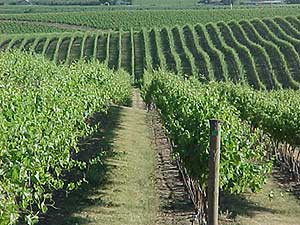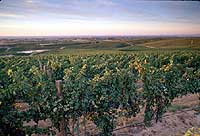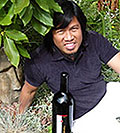Walla
Walla Wine Wallop
The Compelling Call of Walla
Walla
by
Randy Caparoso
 |
Walla Walla Valley |
What's
up with Walla Walla, and why are so many people going there? Washington
State's Walla Walla Valley is now making some earth shattering wines,
belying the region's non-reputation just ten, fifteen years ago.
Admittedly,
when I first visited Walla Walla in the early ‘90s I found
lots of space. Granted, I like space; lots of empty space and the
peaceful feel of nothingness that comes with it. But Walla Walla's
was filled by less than a handful of wineries, some barely more
than barns, making wines that hurt with unruly tannin. The amenities
consisted of roadside motels with nailed-down television remotes
and things like railroad cars disguised as restaurants. We did not
part with sweet sorrow that first time around.
But
like so many first impressions, mine was badly mistaken. For starters,
the Walla Walla Valley is truly deserving of its own official American
Viticultural Area (AVA) designation, garnered in 1984 by the region's
grape growing pioneers. Walla Walla is defined by an ideal length
of growing season and precisely the type of well drained soils that
classical grape varieties love. And once Leonetti Cellar's Walla
Walla Valley-grown Merlots and Cabernet Sauvignons reached a cult
status in the mid ‘90s, the onslaught hit.
Today
the Walla Walla Valley is filled with no less than 53 operating
wineries. Emboldened by the call of the ultra-premium grape, the
vintners recently formed their own marketing resource and technical
exchange, officially known as the Walla Walla Valley Winery Alliance.
So
it was, only this spring, that I found myself beckoned by a Walla
Walla siren—or rather, the WWVWA's dynamic executive director,
Krista McCorkle—who compelled me to drive up the entire coast
of California and through the bucolic Willamette Valley (without
stopping once for a nip of Oregon's famous Pinot Noirs), veering
east from Portland along the undulating Columbia River until I reached
the community of Walla Walla, population 29,500. Compared to my
first visit, it was as if my grainy black and white screen had turned
into gloriously digitized color, as what I found was a lovingly
restored, fresh, thriving destination. Here are but a few of the
culturally pertinent facts that the commanding McCorkle proceeded
to whip into me:
•
Named one of 12 "Distinctive Destinations"
by the National Trust for Historic Preservation, Walla Walla's
combination of historic sites and family activities now take
a backseat to few cities, big or small.
•
If you appreciate size and persistence, for instance,
you'll enjoy finding the oldest continuous symphony orchestra
west of the Mississippi in Walla Walla, as well as 59 of the
state's "Champion Trees" in Robert Van Pelt's book,
Champion Trees of Washington State.
•
Many such natural wonders (among others, silver maple,
black walnut and sycamore trees) can be found in the town
center's Pioneer Park, partially constructed by architect
John Olmstead, who designed New York's Central Park.
•
Walla Walla gets noted not only for its trees and
wines, but also for downtown preservation. Sunset Magazine
recognized Walla Walla as having the "Best Main Street
in the West" in 2002, just one year after the National
Trust for Historic Preservation granted the city a "Great
American Main Street Award."
•
The oldest standing banking institution in Washington
State happens to be in Walla Walla (on Second and Main), as
are tons of historic homes (including one by Frank Lloyd Wright).
•
Walla Walla knows the arts, evidenced by a John Muir
publication that includes it as "One of the 100 Best
Small Art Towns in America."
•
Although heart clogging biscuits and gravy may still
be part of the culinary landscape (Tommy's Dutch Lunch is
a decidedly local experience, but what of it, buddy?), so
are skinny lattes and waitresses, oysters with citrus aioli,
and wood grilled hanger steaks with freshly grated wasabi
mash (Creektown Café, for instance, also features a
nifty, Napa Valley-less wine list).
•
This riverside haven (Walla Walla translates as "many
waters" from the native language) is where Lewis and
Clark were once wise enough to set up long-term camp. For
you history buffs, there's a well marked Lewis & Clark
Trail State Park as well as a life-size diorama in the Fort
Walla Walla Museum. |

What it comes down to, my friends, is that Walla Walla is not, and
never has been, a bald spot at the end of the road; and it's been
a long time since I've been as excited by a single group of wines,
after tasting through the current releases from 35 of Walla Walla
Valley's producers. Here are the highlights, in order of my favorites:
2002
K Vintners, "Milbrandt Wahluke Slope" Syrah ($21)
– We've seen these kinds of firebrands before: K's winemaker/president,
Charles Smith. The K's aromatics are loaded with sweet violets,
cured meats, and crackling pepper – positively screaming "Syrah"—and
on the palate, the plush fruit comes wall-to-wall within a full,
luxuriously textured structure. Put it this way: when was the last
time you tasted a wine that made you sing "glory, hallelujah?"
You will!
2000
Northstar, Walla Walla Valley Merlot ($60) – The
ubiquitous Merlot may have become a global schtick, but in the Walla
Walla Valley it still means something special; and this is as good
it gets in this world, or any other world: a gloriously intense
and multi-faceted nose (think juicy, dripping red berries with a
tinge of pomegranate), translating into draping, fleshy, velvety
smooth layers, and then some more layers, on the palate. Sensational.
2001
Spring Valley Vineyard, Walla Walla Valley Cabernet Sauvignon
($45)—A frenzy of bright, juicy, framboise-like fruit snaps
at you in the nose; and on the palate, notably firm (the essence
of tannin management) yet luscious flavors finish long, lovely,
almost sweet. This estate, planted in 1993, now seems to be hitting
a full stride while showing a fine touch, with worldly ramifications.
2002
K Vintners, "The Beautiful" Walla Walla Valley Syrah ($24)
– This appears to be the bigger brother to K's "Milbrandt"
Syrah, and you may like it better: bigger, meatier, yet lusciously
fruited in the house style, after leading off with playful, jabbing,
floral and fenneled sausage-like spices in the nose. "Beautiful,"
you might say, in a sort of hunky, engagingly bratty way.
 |
| L'Ecole
No. 41 |
2001
L'Ecole No. 41, "Seven Hills Vineyard" Merlot ($40)
– One of Walla Walla Valley's most visible landmarks, L'Ecole
No. 41 has seldom taken a backseat to any Merlot producer (in or
out of Washington St.) since taking up residence in 1983 in the
historic Frenchtown School along Hwy. 12. This bottling executes
the many charms of the grape – lush, sweet berry aromatics,
and thick, rippling, yet alluringly round, juicy flavors –
with uncommon focus, and a restorative sense of elegance.
2001
Glen Fiona, Walla Walla Valley Syrah ($20) – Glen
Fiona is to be commended for many things; not in least for their
fair pricing, belying the lavishly attentive, innovative approach
to their particular obsession: to produce the best Syrah on the
planet. They are one of the few in the U.S., for instance, sensible
enough to ferment Viognier (10% in this bottling) together with
Syrah, rather than shotgunning the two after separate fermentations.
This attention to detail shows: lovely, lilting, sweetly scented
nuances of floral fruit and dried Provencal herbs in the nose, slipping
in on a deceptively smooth, lush, harmoniously textured palate feel.
 |
2002
Spring Valley Vineyard "Uriah" ($45) –
In some circles this assemblage of Merlot (65%), Cabernet Franc
(30%), and Petit Verdot ($5) might be pigeonholed as a Meritage,
a made-up name for Bordeaux-style American blends that is supposed
to suggestively rhyme with "heritage." The term, however,
seems too contrived, blocky, and formulaic for my taste; and heck,
no one remembers how to pronounce it. In any case, in no way would
it give justification to the lovely, lacy, effortlessly smooth,
brightly original, opulent fruit-on-flower-petal beauty of the "Uriah."
This is the "new" Walla Walla Valley at its best; capturing
honest, natural flavor with uncompromising refinement.
2001
Walla Walla Vintners, "Washington State Cuvee" ($28) –
You might find this blend—47% Cabernet Sauvignon, 28% Merlot,
22% Cabernet Franc, and 3% Petit Verdot – to be an even prettier
and more complex companion piece to the Spring Valley "Uriah."
I love the nose—vanilla bean spice and cocoa dusted, sweet
berries—and the fine, elegant, evenly flowing rush of flavors
filled out by gently rounded tannin.
2001
Amavi Cellars, Walla Walla Valley Syrah ($28) – How
much more proof does anyone need that Syrah has found a natural
home in this Great Wide Open? This exciting first release (only
400 cases) flashes bulging muscle, a fleshy opulence, concentrated
spice (smoked meats and licorice), and gobs of black, wild berry:
nothing resembling the French, nor the Aussies, and certainly not
the raggedy Californians, but inimitably a "Walla Walla Valley
Syrah" in its full fledged configuration and almost unconsciously
accomplished feel.
So
the next time you are considering a getaway that fulfills your longing
for nothing, yet combining your need for historical, cultural and
gastronomic stimulation, by all means log on to www.wallawalla.org
or www.wallawallawine.com.
| Randal
Caparoso is a well-known multi-award winning wine director
and founding partner of the Roy's restaurant group. He
has recently started his own wine label project called
Caparoso Wines and has written a book called Winning
Boy, and many articles for The
Honolulu Advertiser since 1981. |
 |
|
|
